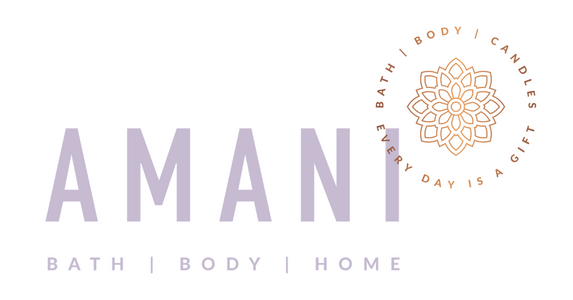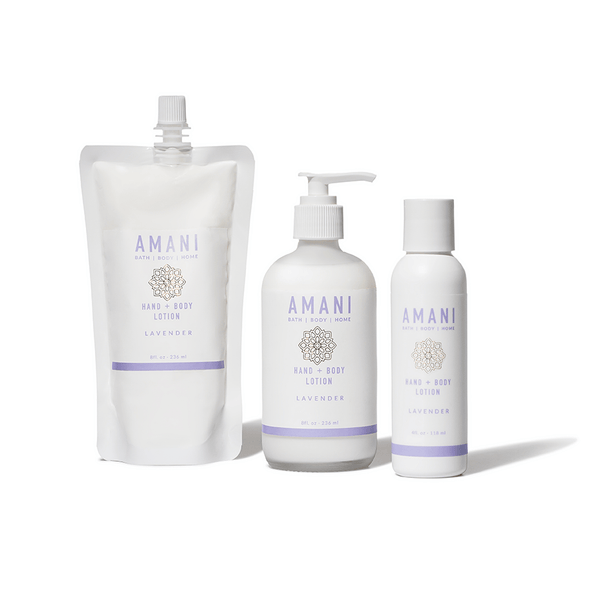Behind the scenes at Amani: Lotion
Sep 16, 2022
Lotion making feels like a mix of chemistry with a bit of magic. Shout out to Dr. Collins, my college professor and advisor for instilling in me a love for all things chemistry.
A lotion is comprised broadly of four general ingredients: water, oil, an emulsifier, and a preservative. Before we go any further, let me just state for the record that a preservative is an absolute necessity for a traditional lotion. Here's why: bacteria love water. Every lotion without a preservative will eventually grow bacteria, mold and all sorts of nasty things. And, just because you can't see it, doesn't mean it isn't there. Something "natural" does not automatically equal "safe".
Some folks get around this by making a "lotion bar", which is a solid moisturizer without any water or water-based product (for example, aloe vera juice). A lotion bar is usually made with a combination of solid oils and butters plus beeswax as a hardener. I personally don't like them because they tend to be heavy and greasy. The cosmetic giant Lush makes a preservative-free lotion but (and this is a big but) it MUST be refrigerated at all times AND it still has a very short shelf life. That's just a bit too iffy for my likes; I can easily see myself forgetting to put it back in the fridge (plus that's just weird) or forgetting how long I've had it. So, if having a preservative-free product is important to you, then I would recommend sticking with a lotion bar.
Back to the post...A lotion is made with water, oil, an emulsifier and a preservative. I suggest looking lotions that have a combination of several oils/butters as this will help to maximize the beneficial properties of each individual component. Over the past several years, I have formulated a recipe that uses a combination of oils and butters which together make a light, non-greasy lotion. I start with a base of mango butter which is both moisturizing and occluding (keeps water from evaporating) and has great polyphenols (but I'll spare y'all the explanation of all that). I then use two different oils, one which is lightweight and another which is a medium weight. Apricot kernel oil is light and well absorbed by the skin. It has softening, regenerating, and moisturizing properties. Rice bran oil is a medium weight oil with lots of Vitamin E. It also penetrates well to moisturize and soften skin. The combination of both light and medium weight oils ensures that it will absorb quickly (apricot oil) and also have a "staying power" (rice bran oil) over time.
The water component of a lotion frequently contains more than water! Who knew? In our case, it also includes glycerin and sodium lactate. Both of these ingredients are great humectants, which means they draw in water from the atmosphere. The glycerin I use is derived from soy. Sodium lactate is a salt dissolved in water; it comes from the fermentation of corn and beets.
The emulsifier breaks the surface tension between oil and water so that the oil droplets become suspended in water. The emulsifying wax I use is made from Cetearyl Alcohol (and) Ceteareth-20, two products derived from coconut oil. I also use cetyl alcohol which helps to emulsify and thicken the lotion.
Like I said, I do use a preservative. I have chosen Liquid Germall Plus, which is effective, reliable and heat-stable. There are other preservatives on the market, however, many of them can cause your lotion to separate so they are very tricky to use. My personal feeling is that the risk from an un- or under-preserved lotion is more than from one that is properly preserved.
In case you're wondering, soap (liquid or bar) does not need a preservative because it has a higher pH. Lip balm also does not need a preservative because it does not contain water. Products such as salt or sugar scrubs are a bit more complicated as there are some that are emulsified (meaning they contain water and therefore need a preservative) or they can be water-free. The problem is when you use the scrub, you run the risk of introducing water if your hands are wet. Therefore, I'd suggest using an emulsified scrub with a preservative or keeping your scrub away from the shower and making sure your hands are dry when you reach in to scoop out the product.
So...how does all this magic come together? It's not nearly as hard as you might think but you must make sure to measure accurately and follow proper sanitation guidelines to avoid introducing contaminants into your lotion. Two separate components are made: a water phase and an oil phase. You water phase will contain water, sodium lactate, and glycerin. Your oil phase will contain all oil-based components: oils, butters, emulsifying waxes, and alcohols plus Vitamin E oil (a teeny tiny bit is all you need). Each of these components is then heated on the stove until they reach a minimum of 165F and then held at that temperature for 20 minutes. This "heat and hold" process serves two functions. First, it reduces microbial levels by killing most bacteria in the water (the preservative will take care of the rest). Second, it makes it easier for the oil phase to break into very small droplets called micelles. The smaller the particle size, the more stable the lotion. After 20 minutes of heating, the two phases (oil and water) are combined and mixed at high speeds until emulsified. Then the lotion is slowly cooled in an ice bath. As it cools it will thicken more. Once it reaches the right temperature, the preservative and fragrance are mixed in. After that, you only have to bottle your lotion and it is ready to use!
Do you have questions about lotions? Post them in the comments below and I will do my best to answer them!


